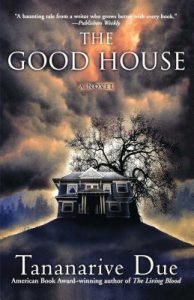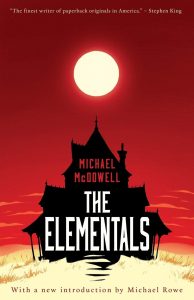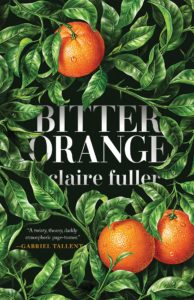The days are getting longer, the nights shorter. Cicadas buzz, a relentless nervous drone; you try to breathe, but the air is dense and suffocating. In the distance, the atmosphere shimmers—or is that a hallucination? Are you going insane?
The stifling days of summer make a perfect setting for eerie stories. In these long, strange days we find ourselves in a liminal zone of heightened temperatures, tempers, and lusts. When writing my novel Catherine House, which takes place over three years at a mysterious secluded university, I found that the summer chapters were the most claustrophobic and sinister. Here are eight novels set during those anxious, menacing summer days—days too hot for anything more than flipping pages in a book.
The Little Stranger, by Sarah Waters
From the very beginning, The Little Stranger is a ghost story turned inside out; we arrive at Hundreds Hall not on a dark, stormy night but on a bright, parched day. It’s summer in postwar England, and country physician Dr. Faraday has been called to a patient at the Ayreses’ family home. When he arrives at the once-grand Georgian mansion, he finds it in a state of decay; the flagstones are choked with weeds, the walls pied with water damage, the masonry powdering to dust. The aristocratic family living amid this decrepitude are well groomed, stifled, and ambivalent to the world that is leaving them behind. But over the course of his summer at Hundreds Hall, Dr. Faraday realizes that the house may be haunted by something other than the Ayreses’ languishing lifestyle—something much more sinister.
Fever Dream, by Samanta Schweblin
Fever Dream is structured as a spare dialogue between two figures: a young woman dying in a clinic and the boy kneeling next to her, David, who is not her son. They’re like worms, David says to the woman, as if to explain why she’s dying. Slowly, David draws her into recounting the events of a recent afternoon, trying to place the exact moment when the worms entered her body. The images in the story she tells—a gold bikini, sweltering soy fields, a brick well, the stones hot to the touch—are impressionistic and unsettling, like a nightmare that’s hyper-detailed but doesn’t quite make sense. You’ll read this book in one uneasy sitting, with a rising sense of stifling dread.
The Good House, by Tananarive Due
The home that belonged to Angela Toussaint’s late grandmother is so treasured by the community of Sacajawea, Washington that they call it the Good House. But Angela hasn’t been back to the house in two years, since the Fourth of July party when her son, Corey, died by suicide in its basement. Angela returns to the home only with hopes of selling it once and for all. When she arrives in Sacajawea, though, she learns of the other tragic events that have recently befallen the community—and she starts to suspect that there may have been more to her son’s death than met the eye. This is a cross-generational story of secrets and lies, racial hurts and fiery, bitter resentments.
The Member of the Wedding, by Carson McCullers
If you’re looking for a sinister summer read, there are many wonderful Southern Gothic novels to choose from, but this is my particular favorite. It’s a “green and crazy” summer, the story begins, and Frankie is twelve years old, that menacing limbo age between girlhood and whatever’s next. As she sits at the kitchen table with her housekeeper and cousin, playing cards in the suffocating late-August heat, she dreams of something larger than herself, something crisp and cold and big and adult: something like her brother’s upcoming wedding in Winter Hill, Alaska. Dream becomes obsession, and soon Frankie finds herself with a sudden, violent view of a more grown-up world, one full of threats and desires that she doesn’t understand.

Wylding Hall, by Elizabeth Hand
Wylding Hall is the oral history of Windhollow Faire, a British acid-folk band that never was. After the mysterious death of one of their founding singers, the band retreats to a remote country estate called Wylding Hall to regroup and write some new songs. The album they record sounds like their summer days in the house: languid, romantic, and gorgeous. But the band’s dreamy paradise is quickly spoiled when their lead singer, the beautiful Julian Blake, disappears somewhere in the maze-like house and is never heard from again. The novel’s story is told through interviews with the surviving band members, as well as their manager, friends, and lovers, as a documentary team tries to figure out what really happened that strange summer.
The Elementals, by Michael McDowell
The McCrays and the Savages, two families connected by marriage, vacation down to Alabama’s Gulf Coast after the death of their matriarch. There, at Beldame, three Victorian mansions loom over a shimmering beach. The McCrays stay in one house, the Savages in another, and the third house, half buried in sand, lies empty—at least, empty of anything human. Over the course of their summer on the coast, in the vivid, violent, annihilating heat, the families slowly realize that the decay eating at the third house may be malignant than it seems. The Elementals is a classic of the 1970s-80s horror paperback boom, and a fun Southern twist on a classic gothic haunted house story.

Real World, by Natsuo Kirino
When Toshi, a teenage girl living in a crowded, smoggy Tokyo suburb, hears that her next-door neighbor has been viciously murdered, she immediately suspects she knows the killer: the neighbor’s son, a lanky, gloomy high schooler she calls Worm. Worm has fled, taking Toshi’s bike and cellphone with him. Instead of reporting Worm to the police, Toshi covers up his lies—and soon she and her friends are caught up in a dangerous world of insanity and slaughter. As the tensions rise, the air pollution siren blares, anxious but indifferent.
Bitter Orange, by Claire Fuller
We meet Frances Jellico, the narrator of Bitter Orange, on her death bed in an unspecified institution. As she languishes of old age and disease, she remembers the summer of 1969, the days she spent as a researcher at an English country mansion called Lyntons. Frances isn’t alone at Lyntons; a couple is staying on the floor below hers, a young man and woman who are glamorous, decadent, hedonistic, everything Frances is not. When Frances discovers a peephole beneath her bathroom floorboards, she finds herself spying on the couple, and soon develops an obsession with them and their private lives. Present-day Frances sees the summer through a haze of sleepy nostalgia, the way we often remember our summers. But as she tells her story, we realize that in the simmering heat of Lyntons, right may have blurred into wrong, truth into lies, and one crime into a much bigger one.
***
























